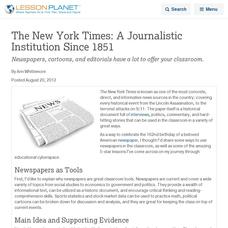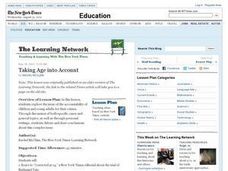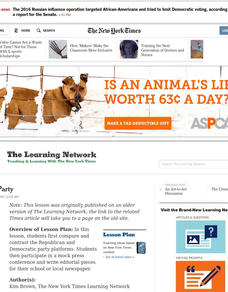Curated OER
Opinion through the Ages: Exploring 40 Years of New York Times Op-Eds
What is the role of a newspaper's Op-Ed page? High schoolers explore the New York Times' "Op-Ed at 40," an interactive feature that lets them browse through 40 years worth of op-ed features, and consider the purpose and value of this...
Curated OER
Student Opinion: What Small Things Have You Seen and Taken Note of Today?
An interesting and unusual topic for a news article, this resource from the New York Times website asks learners to take a moment and consider all the things they notice during a typical day. Based of the editorial piece "Things I Saw"...
Curated OER
The New York Times: A Journalistic Institution Since 1851
Newspapers, cartoons, and editorials have a lot to offer your classroom.
The New York Times
News and News Analysis: Navigating Fact and Opinion in the Times
Help your class understand the difference between fact and opinion by exploring the New York Times homepage and articles. In pairs or small groups, pupils complete a scavenger hunt, answering the provided questions. Next, discuss the...
EngageNY
Peer Critique and Revision: Editorial Essay
Get those red pens ready! Using the Peer Critique protocol, scholars provide and receive feedback on their editorial essay drafts. They then use class time to work on revisions.
Curated OER
Separate But Equal Opinions
High schoolers examine the ways in which editorials and Op-Ed pieces respond to current events. They write editorials in response to news items from the New York Times.
Curated OER
Taking Age into Account
Have your class consider the issue of minors' accountability for their crimes. They discuss specific cases and the general issue of juvenile crime in round table discussions. Use this lesson to emphasize the rules and individual roles...
Curated OER
The Unspoken Words of Media Ethics: Do we know what they are?
Students read codes of ethics from the New York Times, Washington Post, Society of Professional Journalists and the American Society of Newspaper Editors. In this Civics lesson, 10th graders role-play ethical dilemmas faced by reporters.
Curated OER
Strong Convictions
How can the rhetorical structure of an editorial help to develop its argument? Use this New York Times editorial to emphasize the importance of structure in a piece of informational text. Adolescent writers then use the editorial as a...
Curated OER
What Now?
Students consider local and national divisiveness over the presidential elections by examining a New York Times editorial and then writing op-eds suggesting how to address post-election discord in their schools and/or communities.
Curated OER
Interactive Duty
Students consider the role of multimedia news features. They analyze the New York Times coverage of the president's State of the Union address.
Curated OER
All the President's Men and Women
Learners research responsibilities, programs and government departments of leaders that make up the presidential cabinet, in the form of a Web Exploration, after reading "Dueling Power Centers" from The New York Times.
Curated OER
Scooting Away from Justice?
Students examine President Bush's July 2007, decision to commute the 30-month sentence of former White House official, I. Lewis 'Scooter' Libby by reading a New York Times article. They scan editorial sources on various sides of the...
Curated OER
What's Your Angle?
Students examine The New York Times' coverage of immigrants' rights in order to gain an understanding of how different news angles function. They assess the angles of different news media outlets, such as television, radio, and Internet...
Curated OER
A New Deal for Peace in a Land of War
Students explore the causes and effects of recent conflicts in the Balkans, and discover the current peacekeeping attempts by NATO and the new Yugoslav government. They research an aspect of the Kosovo conflict and prepare skits based...
Curated OER
It's a Draw!
Students assess the ways in which editorial cartoons, both current and historic, offer insight into events that shape our world. They create a poster that includes a current editorial cartoon and their explanation of the details of the...
Curated OER
It's My Party
Students compare/contrast the Republican and Democratic platforms using Venn diagrams, then read and discuss, "The Conventions Are Over. The Party's Just Starting." students then participate in a mock press conference and write editorial...
Curated OER
On the Leading Edge
Students write an op-ed piece concerning presidential leadership. After reading an archived article from The New York Times, students compare and contrast the leadership styles of former Vice President Al Gore and President George W....
PBS
The Media and the War: The Penny Press, Walt Whitman and the War
The Mexican-American war marked a significant moment in United States history, as well as in the history of American media. The mid-nineteenth century saw the introduction of the Penny Press, which provided many American citizens with...
The New York Times
I Don’t Think So: Writing Effective Counterarguments
When it comes to writing effective arguments, writers must do more than simply make a claim, counterarguments must be considered. Aspiring writers analyze counterarguments in editorials, and then learn how to write counterarguments in...
Curated OER
Cartoons for the Classroom: 9/11 Revisited
Political cartoons about the September 11 terrorist attacks provide an opportunity for class members to analyze the inferences embedded in the drawings.
Curated OER
Re-Viewpoints From 2002
Students explore how editorials use various devices to convey a message to a reader. They select key news topics from 2002 and write their own editorials.
Curated OER
A Choice of Voice
Team work can produce great results. Your class will analyze the design, news content, and demographic profiles of local alternative newsweeklies. They then design and write articles for their own community working together as editorial...
Curated OER
Digesting the News
Students explore the editorial concepts, site designs and business models of online news digests. They propose detailed plans for Web sites that demonstrate their own areas of expertise.

























